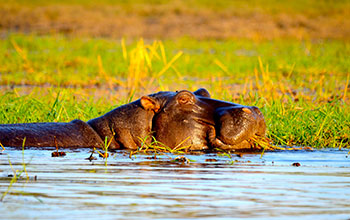Multimedia Gallery
Hippos have higher levels of antibiotic resistance than non-water species
A recent study found that water species such as hippos have higher levels of antibiotic resistance than non-water species.
More about this image
The emergence of antibiotic resistance is an important threat to human and other animal health, globally, but scientists say monitoring resistance in wildlife can help.
In a recent National Science Foundation (NSF)-supported study, researchers report that differences in lifestyles among species can provide critical insights into the mechanisms of antibiotic spread.
Kathleen Alexander of Virginia Tech and Sarah Jobbins of the University of Sydney tested for resistance to 10 antibiotics among 18 wildlife species and cattle. The biologists explored key attributes and behaviors that may increase exposure and allow resistance to move between humans, other animals and ecosystems.
The researchers used the common intestinal bacteria E. coli to evaluate antibiotic resistance exposure in humans, domestic animals and wildlife communities in Northern Botswana. Among 150 wildlife samples, 41 percent contained E. coli isolates that were resistant to at least one or two of the 10 antibiotics tested, while 13 percent were resistant to three or more, and considered to be multidrug resistant.
Multidrug resistance was found across land types, from areas of human habitation to protected areas such as national parks.
Surface water is a critical shared resource for humans and other animals, particularly in dry regions of the world such as Botswana. Multidrug resistance was significantly higher in water-associated species such as hippopotamus and otters; carnivores such as crocodiles, leopards, and hyenas; and species inhabiting urban areas such as baboons and warthogs. Aquatic or semi-aquatic animals such as crocodiles, otters and waterbucks harbored significantly greater levels of multidrug-resistant E. coli, said Jobbins.
However, Jobbins says consumption of water alone was not the driver here. "Several water-dependent species such as impala, buffalo, cattle and sable had little or no evidence of exposure to antibiotic resistance. These findings suggest that the duration of exposure and consumption of water-inundated vegetation and sediment might be the key to exposure and transmission of resistant microbes," says Jobbins.
Multidrug resistance was also significantly higher in carnivores, animals at the top of the food chain that might have greater exposure to antibiotic resistance through diet.
Jobbins and Alexander's study, they say, is one of the few to examine antimicrobial resistance in a broad range of hosts in their natural environment. The researchers concluded that long-term monitoring of antimicrobial resistance among top predators and water- and human-associated species may help in detection and control of the spread of antimicrobial resistance.
The research was funded by NSF's Dynamics of Coupled Natural and Human Systems Program (grants DEB 11-14953, DEB 05-15914 and DEB 14-39246).
To learn more, see the NSF Discovery news story Wildlife species provide clues to spread of antibiotic resistance in Africa. (Date image taken: 2010-2015; date originally posted to NSF Multimedia Gallery: Nov. 4, 2015)
Credit: Kaitlin Vandewalle
See other images like this on your iPhone or iPad download NSF Science Zone on the Apple App Store.
Images and other media in the National Science Foundation Multimedia Gallery are available for use in print and electronic material by NSF employees, members of the media, university staff, teachers and the general public. All media in the gallery are intended for personal, educational and nonprofit/non-commercial use only.
Images credited to the National Science Foundation, a federal agency, are in the public domain. The images were created by employees of the United States Government as part of their official duties or prepared by contractors as "works for hire" for NSF. You may freely use NSF-credited images and, at your discretion, credit NSF with a "Courtesy: National Science Foundation" notation.
Additional information about general usage can be found in Conditions.
Also Available:
Download the high-resolution JPG version of the image. (5.7 MB)
Use your mouse to right-click (Mac users may need to Ctrl-click) the link above and choose the option that will save the file or target to your computer.

 All images in this series
All images in this series